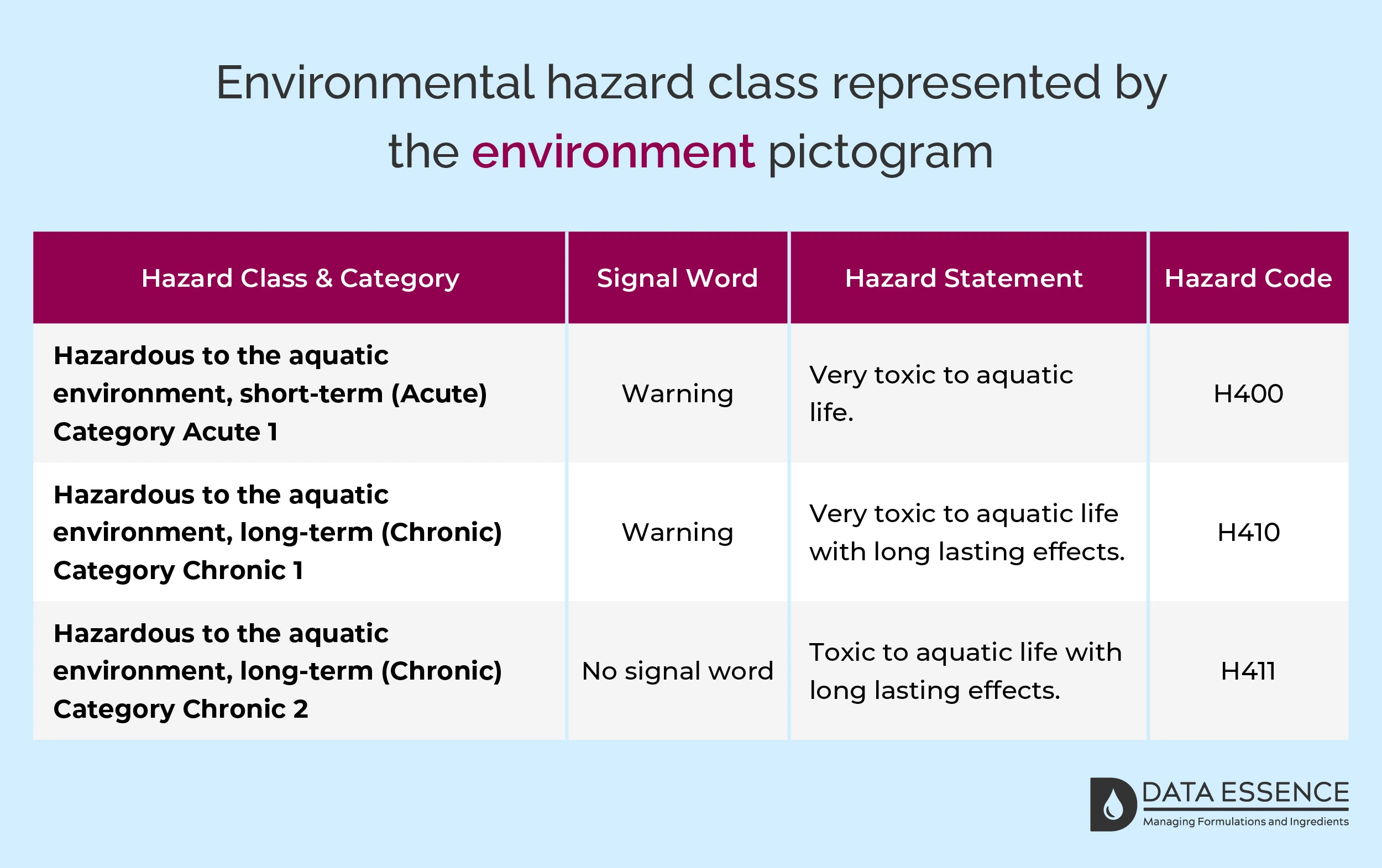Whether you already handle environmentally hazardous products or are simply interested in learning more about the necessary safety precautions, this blog post will provide you with valuable insights to protect yourself and others from potential hazards.
What does the environment pictogram mean?

What are hazards to the environment?
- Short-term (acute) hazards: Short-term hazards assess the immediate impact of a product on aquatic life. This examination scrutinises how the product affects aquatic organisms in the short-term.
- Long-term (chronic) hazards: Conversely, long-term hazards delve into the sustained, chronic effects of a product on aquatic life. These effects encompass two critical aspects:
-
- Bioaccumulation: Bioaccumulation is the gradual buildup of a product within aquatic organisms. While it may not necessarily exhibit immediate toxic effects on these organisms, it is a cause for concern. This concern arises because as organisms within the food chain consume one another, the accumulated product levels increase. Over time, this can lead to adverse consequences.
- Degradation: Degradation focuses on a substances ability to break down over time in the environment. It evaluates whether the product is persistent or readily degradable. Persistent products can have significant impacts, including reduced spawning, genetic issues in offspring, and behavioural alterations among aquatic life.
Environmental hazard class represented by the hazardous to the environment pictogram
The hazard class represented is hazardous to the aquatic environment, short-term (acute) and long-term (chronic). We will look at this hazard class in relation to signal words, hazard statements and hazard codes.

The implications of hazards to the environment
Risks to aquatic life
- High toxicity: These substances are very toxic or toxic to aquatic life, signifying their potential to harm organisms residing in water bodies.
- Long-lasting effects: The impact of these substances is enduring, with the potential to disrupt aquatic ecosystems over extended periods.
Commonly encountered substances
The Hazardous to the Environment symbol is frequently displayed on a range of materials, including but not limited to:
- Pesticides: Chemicals used to control pests in agriculture and other settings.
- Biocides: Agents employed to combat unwanted biological organisms.
- Petrol: A ubiquitous fuel source with significant environmental implications.
- Turpentine: A solvent and paint thinner used in various applications.
Protective measures for hazardous to the environment substances
- Environmental stewardship: As a fundamental principle, strive to avoid the release of these substances into the environment at all costs. Containment and responsible disposal are key.
- Spill response: In the unfortunate event of a spill or accidental release, immediate action is imperative. All spilled material should be promptly and carefully collected, minimising the environmental impact.
Safe storage for hazardous to the environment substances
When handling products bearing the environmental hazard pictogram, it is imperative to prioritise safety during storage. Here are essential guidelines to securely store such products:
- Secure, well-ventilated location: Store the product in a secure, dry, and well-ventilated area. Ensure that the storage area is equipped with sills to prevent any potential leaks from escaping into sewers or surrounding environments.
- Implement secondary containment: Utilise secondary containment measures, such as drip trays, to effectively contain any potential leaks or spills from the product. Regularly empty these trays to prevent overflow and maintain their efficacy.
- Monitor product usage: Keep a vigilant eye on the usage of the product. Sudden and unexpected increases in usage may be indicative of a leak or spill, warranting immediate attention.
- Isolate loading and unloading areas: Whenever possible, isolate loading and unloading areas from surface water drainage systems. If complete isolation is not feasible, take measures to safeguard nearby drains. This can be achieved by using covers, sandbags, or other suitable barriers to prevent any accidental runoff of the product into the drainage system.
By adhering to these prudent storage practices, you can minimise the environmental risks associated with products featuring the environmental hazard pictogram and contribute to a safer working environment.
Conclusion
By acknowledging the potential risks associated with environmental hazards, which encompass a range of factors, with a primary emphasis on the toxicity of products to aquatic life. Understanding both short-term and long-term effects, such as bioaccumulation and degradation, is essential to grasp the potential environmental risks associated with a product bearing the environmental hazard pictogram. By implementing appropriate safety measures, we create a safer working environment for employees and minimise the possibility of accidents. Storing, transporting, and handling these products in accordance with the environment pictogram guidelines is essential to protect not only employees but also to safeguard the environment for generations to come.

